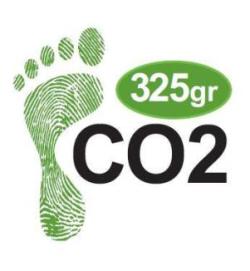What is a footprint?
 A carbon footprint measures the total greenhouse gas emissions caused directly and indirectly by a person, organisation, event or product.
A carbon footprint measures the total greenhouse gas emissions caused directly and indirectly by a person, organisation, event or product.
The footprint considers all six of the Kyoto Protocol greenhouse gases: Carbon dioxide (CO2), Methane (CH4), Nitrous oxide (N2O), Hydrofluorocarbons (HFCs), Perfluorocarbons (PFCs) and Sulphur hexafluoride (SF6).
A carbon footprint is measured in tonnes of carbon dioxide equivalent (tCO2e). The carbon dioxide equivalent (CO2e) allows the different greenhouse gases to be compared on a like-for-like basis relative to one unit of CO2. CO2e is calculated by multiplying the emissions of each of the six greenhouse gases by its 100 year global warming potential (GWP).
For simplicity of reporting, it is expressed in terms of the amount of carbon dioxide, or its equivalent of other GHGs, emitted.
What is a Product Carbon Footprint?
A Product Carbon Footprint is the total carbon dioxide (CO2) and other greenhouse gases emitted during its life, including production, use and disposal. For example, the carbon footprint of a bar of milk chocolate includes the emissions from the dairy cows, growing the cocoa beans and sugar, making the packaging and turning the ingredients into chocolate. It also includes the emissions from transportation and retailing as well as disposal of the packaging.
Why should you measure your Product Carbon Footprint?
With the demand for fast and dramatic action to reduce global carbon emissions, the need to accurately measure those emissions to an international standard has never been greater. The good news is that there are many commercial benefits to measuring your product’s carbon footprint as well as the climate change impact.
Understanding how your products and supply chains are responsible for carbon emissions helps you to identify the most effective ways of reducing them. It highlights opportunities for greater energy efficiency, reduced waste, streamlined logistics and other efficiencies. Measuring your product’s carbon footprint is a critical process to help you cut costs, manage climate risks and enhance your brand reputation. In every sector, from brewing to banking, consumers want to make an informed choice between products that are committed to reducing their environmental impact and those that aren’t.
How do you develop a carbon footprinting project?






 EU Organic Farming
EU Organic Farming IFOAM
IFOAM IFOAM EU Group
IFOAM EU Group UN FAO Organic Agriculture
UN FAO Organic Agriculture